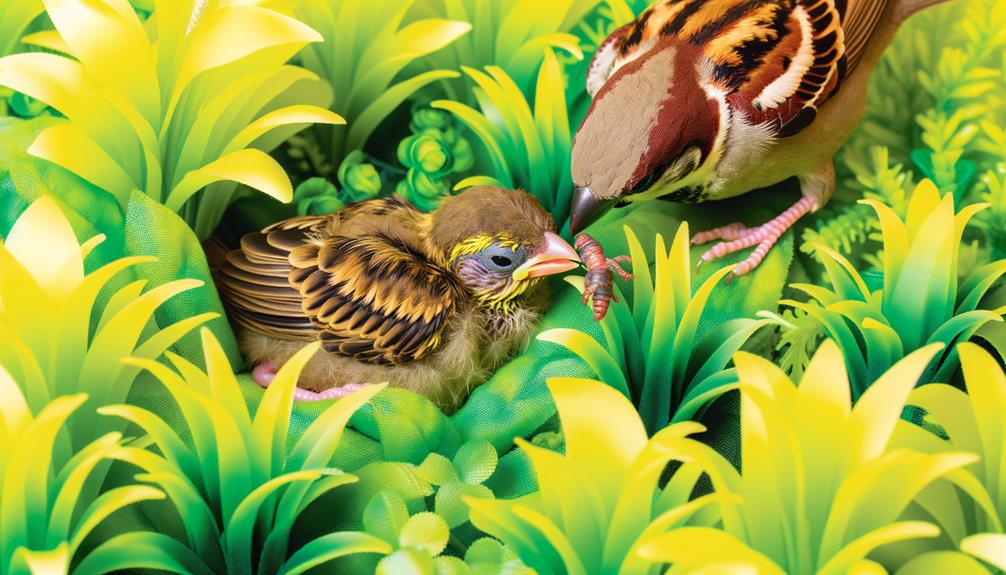Understanding Baby Sparrow Growth: Can It Be Bigger Than Its Parents?
No, a baby sparrow can't be larger than its parents. Genetic constraints and evolutionary mechanisms regulate growth potential, ensuring chicks reach about 80-90% of their adult size by fledging stage.
Robust nutrition and favorable environmental factors support rapid development, but eventual size is inherently limited by inherited genes dictating growth rates and skeletal structures. Mutations can cause minor variations; however, baby sparrows are designed to remain within a specific size range for best survival and reproductive success.
To understand more about these growth dynamics and their influencing factors, keep learning about avian development and genetics.

Key Takeaways
- Baby sparrows typically reach 80-90% of adult size by fledging age.
- Genetic factors set a size limit, making it rare for a baby sparrow to outgrow its parents.
- Nutritional sufficiency and environmental conditions can influence growth rates but within genetic constraints.
- Evolutionary constraints ensure offspring remain within a specific size range for survival.
- While fluffy plumage can make fledglings appear temporarily larger, they usually do not exceed parental size.
Sparrow Growth Stages

Understanding the growth stages of sparrows involves examining their development from hatching to fledging, highlighting key physiological and behavioral milestones.
Initially, hatchlings are altricial, meaning they're born blind and featherless, relying entirely on their parents for warmth and nourishment. Within days, you'll notice feather follicles forming, followed by the emergence of pin feathers. By day seven, their eyes open, and you can observe rapid weight gain and increased activity.
Around day ten to twelve, fledging begins, characterized by fledglings making short, clumsy flights while still dependent on parental feeding. Behavioral milestones include begging calls and initial attempts at self-feeding.
Monitoring these stages closely allows you to understand their growth patterns and how they rely on parental care for survival.
Genetic Influence on Size
You'll find that a baby sparrow's size is greatly influenced by its inherited growth potential, which is dictated by parental genetics. Genetic mutations can also alter size, either enhancing or impeding growth.
Observational studies have shown a direct correlation between parent and offspring size, underscoring the impact of genetic inheritance.
Inherited Growth Potential
Genetic factors play a crucial role in determining the growth potential and eventual size of baby sparrows compared to their parents. By understanding these genetic influences, you can better appreciate how inherited traits shape sparrow development. Research shows that specific genes regulate growth rate, bone density, and muscle mass. Observing these genetic markers helps predict whether a baby sparrow might surpass its parents in size.
| Genetic Marker | Influence on Growth | Observational Evidence |
|---|---|---|
| IGF-1 | Enhances growth rate | Higher levels in larger sparrows |
| BMP2 | Increases bone density | Detected in denser bone structures |
| MSTN | Regulates muscle mass | Lower levels correlate with more muscle mass |
These genetic components ensure that each sparrow's growth potential is largely pre-determined, highlighting the importance of inherited traits.
Genetic Mutations Impact Size
Occasionally, genetic mutations can significantly alter the size of baby sparrows, sometimes resulting in noticeable deviations from their parents' size. These mutations can impact growth hormones, skeletal development, and even metabolic rates. When you're examining these changes, it's essential to take into account their potential effects on a sparrow's survival and ecological role.
Studies have shown that:
- Growth hormone mutations can lead to increased size.
- Skeletal anomalies may cause differences in bone structure.
- Metabolic rate variations can alter energy utilization.
- Developmental gene changes might impact overall growth patterns.
Understanding these factors helps you appreciate the complexity of avian genetics and their ecological implications. By recognizing how genetic mutations influence size, you can better support conservation efforts and guarantee the well-being of these remarkable birds.
Role of Nutrition

Proper nutrition plays a vital role in determining the growth and eventual size of baby sparrows compared to their parents. When you optimize baby sparrows to receive best nutrients, they have a higher chance of reaching or even exceeding their parents' size. Key nutritional components include proteins, fats, and vitamins.
| Nutrient | Impact on Growth |
|---|---|
| Proteins | Essential for muscle development and overall growth. |
| Fats | Provides energy and aids in the absorption of vitamins. |
| Vitamins | Essential for metabolic processes and immune function. |
| Minerals | Supports bone development and cellular functions. |
Studies have shown that a well-balanced diet can lead to improved weight gain and skeletal development in young sparrows, making nutrition a cornerstone for their growth potential.
Environmental Factors
While nutrition undeniably influences the size of baby sparrows, environmental factors also play a significant role in their development. These elements can either facilitate or hinder the growth of young sparrows. Habitat quality is crucial, as sparrows in lush areas may access more resources. Climate is another factor, as temperature fluctuations can affect metabolism and growth rates. Predation pressures also play a role; high predation risk may limit parental foraging efforts. Additionally, pollution levels in contaminated environments can stunt development.
Environmental factors, such as habitat quality, climate, predation pressures, and pollution levels, all interact to shape the growth and development of baby sparrows. These elements work in tandem to influence the overall health and size of young sparrows as they navigate their environment and grow into adulthood.
Avian Development Basics

You'll find that understanding avian development basics involves examining growth phases, nutritional requirements, and genetic influences.
Observations indicate that baby sparrows undergo rapid size changes in their initial weeks, driven by specific dietary needs and inherent genetic factors.
Evidence shows that these elements collectively determine their growth trajectory compared to their parents.
Growth Phases Overview
Understanding the growth phases of baby sparrows, from hatching to fledging, provides detailed insights into their rapid development and the complex physiological changes that occur.
You'll observe that baby sparrows grow notably during their initial weeks. They undergo several critical stages:
- Hatching: The chick emerges from the egg, blind and featherless, relying entirely on parental care.
- Nestling: Feathers begin to develop, and the chick starts to gain weight rapidly, requiring constant feeding.
- Pre-Fledging: The young sparrow's feathers are almost fully developed, and it practices wing flapping.
- Fledging: The chick leaves the nest, capable of short flights, yet still dependent on its parents for food.
These stages are essential for understanding avian development and supporting conservation efforts.
Nutritional Requirements
During the initial weeks of a baby sparrow's life, its nutritional requirements are essential to guarantee proper growth and development. You'll need to provide a diet rich in protein and fats, as these macronutrients are vital for rapid tissue development and energy.
Insects, like caterpillars and beetles, offer high protein content, while seeds provide necessary fats. Observational studies have shown that sparrows fed an inadequate diet can exhibit stunted growth and underdeveloped feathers.
It's important to maintain a consistent feeding schedule, as irregular feeding can lead to malnutrition. Ensuring an ample supply of clean water is equally important to support metabolic processes.
Genetic Influences
Genetic factors profoundly influence the growth rate, feather development, and overall size of baby sparrows compared to their parents.
When you examine the genetic makeup of sparrows, several key elements come into play:
- Genotype Variability: Different combinations of alleles can lead to variations in size and growth rates.
- Heritable Traits: Specific genes inherited from parents determine physical characteristics like feather length and body mass.
- Mutations: Spontaneous genetic mutations can result in offspring that differ significantly in size from their parents.
- Selective Breeding: Over generations, certain traits may be favored, leading to noticeable changes in size and development.
Understanding these genetic influences helps you appreciate the intricate biological mechanisms that dictate avian development and guide effective conservation efforts.
Comparing Parent and Chick Sizes
Juvenile sparrows, often much smaller than their adult counterparts, exhibit rapid growth rates during their early development stages. You'll observe that a chick's initial mass can be just a fraction of an adult's, but they undergo significant weight gain and size increases within weeks.
Detailed measurements show that nestlings can double their weight within the first four days post-hatching. Their skeletal structure, feather development, and muscle mass expand swiftly, driven by high metabolic rates and ample parental feeding.
Studies document that by fledging age, juveniles reach about 80-90% of adult size. Though rare, some fledglings may appear momentarily larger due to fluffier plumage, but this is a transient phase not indicative of true size superiority over adults.
Evolutionary Constraints

You'll observe that genetic size limitations play a pivotal role in determining the size of baby sparrows. Evolutionary constraints often restrict the growth rate factors, ensuring that chicks don't surpass the size of their parents.
Studies consistently show that these limitations are vital for survival and reproductive success in their natural habitats.
Genetic Size Limitations
Evolutionary constraints play a pivotal role in determining the size of baby sparrows relative to their parents, as evidenced by genetic studies highlighting the limits imposed by hereditary factors. Genetic size limitations guarantee that sparrow offspring typically don't exceed the dimensions of their parents.
You can observe several critical factors:
- Genetic inheritance: Offspring inherit size-related genes that dictate maximum growth potential.
- Physical adaptations: Evolution favors traits that optimize survival. Larger size may not always be advantageous.
- Resource allocation: Energy and nutrients are allocated based on genetic instructions.
- Survival rates: Larger sparrows might face higher predation risks or other environmental challenges.
These evolutionary constraints suggest that baby sparrows are inherently designed to remain within a specific size range, ensuring their survival and functionality.
Growth Rate Factors
Understanding the growth rate factors in baby sparrows requires examining how evolutionary constraints such as genetic inheritance, environmental conditions, and resource availability interact to influence development. Evolutionary biology shows that these factors are essential in determining whether a baby sparrow can grow larger than its parents. For instance, genetic inheritance sets a baseline for potential size, while environmental conditions such as temperature and habitat quality can either inhibit or enhance growth. Resource availability, particularly nutrition, is also critical. You can better grasp these dynamics by looking at the following table:
| Factor | Influence on Growth |
|---|---|
| Genetic Inheritance | Baseline size potential |
| Environmental Conditions | Growth enhancement or inhibition |
| Resource Availability | Nutritional impact |
| Interactions | Complex adaptive outcomes |
Case Studies in Bird Growth
One notable case study in bird growth reveals that baby sparrows typically reach approximately 70% of their parents' size within the first four weeks of life. This rapid growth phase is critical for their survival and future development.
By observing their growth patterns, you can gain insights into their nutritional needs and environmental adaptations. Key findings include:
- Nutrient intake: Adequate protein and fat intake accelerate growth rates.
- Parental care: Frequent feeding by parents directly correlates with faster growth.
- Temperature regulation: Ideal nest temperature supports efficient metabolic processes.
- Genetic factors: Inherited traits greatly influence growth potential.
These detailed observations underscore the importance of providing consistent care and monitoring for young sparrows to guarantee their healthy development.
Myths About Bird Growth

Many misconceptions about bird growth persist despite extensive scientific evidence debunking them. For instance, you might think a baby sparrow could surpass its parents in size, but this isn't supported by data.
Nestling growth rates are meticulously documented, showing predictable patterns. Growth spurts occur rapidly within the first weeks post-hatching, but they follow a species-specific trajectory. In sparrows, juveniles typically achieve adult dimensions before their first molt.
Additionally, environmental factors like food availability and parental care influence growth but don't result in a permanent size advantage over parents.
When you observe sparrow growth, remember these evidence-based insights to dispel myths effectively, enabling you to educate others with accurate information rooted in scientific research.
Potential for Size Variation
While myths about bird growth often cloud the facts, the potential for size variation in baby sparrows can still intrigue researchers and bird enthusiasts alike. You'll find that genetic diversity, environmental factors, and individual health contribute to size differences.
Observations show that baby sparrows usually grow to be similar in size to their parents, but slight variations do occur.
To understand this better, consider:
- Genetics: Inherited traits from parent birds can cause slight size differences.
- Nutrition: Adequate feeding during the fledgling stage can impact growth.
- Environmental conditions: Temperature and habitat quality can affect development.
- Health: Disease or parasites can stunt or promote growth.
Conclusion
To sum it up, while it's rare for a baby sparrow to outgrow its parents, it's not entirely out of the question. Various factors like genetics, nutrition, and environmental conditions play crucial roles.
Think of it as a roll of the dice; most offspring stick to the expected growth patterns, but anomalies can occur. Careful observation and scientific evidence suggest potential size variations, yet evolutionary constraints typically keep things in check.
So, don't count your chickens before they hatch.






